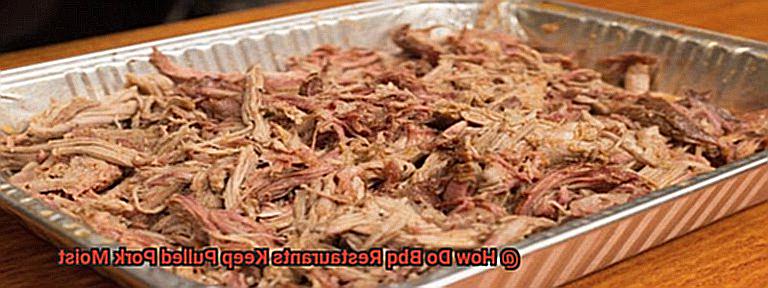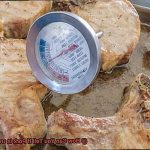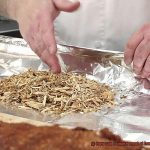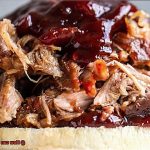Picture this: a sunny summer day, a plate piled high with mouth-watering pulled pork, and a tangy barbecue sauce that’s finger-licking good. But have you ever wondered how BBQ restaurants manage to keep their pulled pork so incredibly moist and packed with flavor? Well, let me tell you – it’s all in the preparation, cooking, and storage techniques used by experienced pitmasters.
One essential technique to keep pulled pork moist is brining. This involves soaking the meat in a mixture of salt and water, which helps it retain moisture during the cooking process. It’s a simple yet effective method that creates a more tender, juicy pork that’s perfect for slow cooking.
But that’s not all. BBQ restaurants also use smoke boxes or foil-wrapping to lock in moisture while infusing smoky flavor into the meat. Smoke boxes allow smoke to penetrate the pork while sealing in moisture, while foil-wrapping creates a steamy environment that allows the meat to cook slowly without drying out.
And let’s not forget about proper storage. Restaurants typically seal their pulled pork in an airtight container or vacuum-sealed bag to help it retain its juiciness until it’s ready to be reheated and served.
So there you have it – the secrets of keeping pulled pork moist from the pros themselves. If you’re looking to create your own perfect pulled pork at home, take these tips and tricks from experienced pitmasters and enjoy your own finger-licking good meal.
Contents
What is Pulled Pork?
Pulled pork is a culinary delight that has been popular in Southern cuisine for centuries but has spread its deliciousness globally in recent years. The process of making pulled pork involves slow cooking a pork shoulder or pork butt until it becomes tender enough to be “pulled” apart into thin shreds and seasoned with a dry rub or marinade before serving on a bun with barbecue sauce.
The challenge of making pulled pork lies in keeping the meat moist throughout the cooking process. Pork shoulder and pork butt are tough cuts of meat that require long, slow cooking to break down collagen and connective tissue to become tender, but this can lead to moisture loss if not done correctly.
Professional BBQ restaurants have mastered the art of keeping their pulled pork moist and flavorful by using several techniques, including:
- Cook low and slow: The key to achieving tender, juicy pulled pork is cooking it low and slow for an extended period. This allows the collagen in the meat to break down and turn into gelatin, which keeps the meat moist and tender.
- Inject with a liquid solution: To add moisture and flavor, BBQ restaurants inject their pork with a liquid solution before cooking. This mixture typically contains apple juice, vinegar, and spices.
- Wrap in foil or butcher paper: Another technique used by BBQ restaurants is wrapping their pork in foil or butcher paper during the cooking process. This method helps to trap in moisture and prevent the meat from drying out.
- Let it rest: Finally, BBQ restaurants let their pulled pork rest before serving. Resting allows juices to redistribute throughout the meat, resulting in a more flavorful and moist final product. It also allows excess moisture on the surface to evaporate, preventing the meat from becoming soggy.
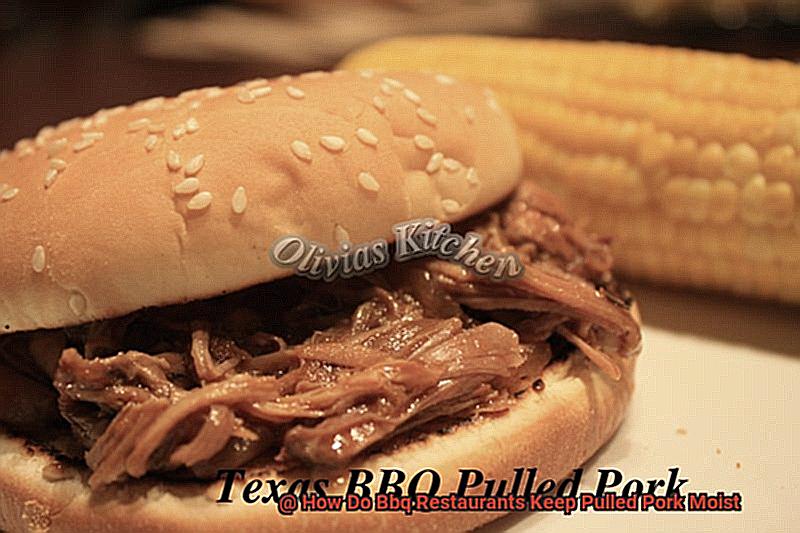
The Benefits of Keeping Pulled Pork Moist
If you’re a pulled pork fan, then you know the importance of keeping it moist to achieve a mouth-watering and tender final product. Moisture is the key to creating a succulent and flavorful dish that will have your taste buds singing. As an expert on the benefits of keeping pulled pork moist, I’m here to tell you all about it.
First of all, let’s talk about texture. Dry pulled pork can be tough and stringy, making it challenging to chew and swallow. Keeping the pork moist during cooking ensures that the meat breaks down quickly, resulting in a more enjoyable eating experience. Each bite should melt in your mouth, leaving you craving for more.
Next up is flavor. When meat is dry, it can be bland and unappetizing. Moisture helps distribute the flavors throughout the meat, making it more delicious and flavorful. Imagine each bite bursting with juicy and savory notes that tantalize your taste buds.
Lastly, maintaining moisture levels throughout the cooking process can prevent the pulled pork from drying out and becoming overcooked. Overcooked pulled pork can be tough and dry, making it less enjoyable to eat. Professional BBQ restaurants use techniques such as cooking low and slow, injecting with liquid solutions, wrapping in foil or butcher paper and letting it rest before serving to lock in the moisture and ensure that every bite is as scrumptious as the last.
To sum up, here are some of the benefits of keeping pulled pork moist:
- Tender and easy-to-eat meat
- Full-bodied flavors tantalize your taste buds
- Prevents overcooking for a juicy and succulent result
Cooking Low and Slow for Maximum Moisture
Fear not, because the secret to achieving maximum moisture and tenderness lies in cooking low and slow. As a seasoned expert in this field, I’m here to share some of my top tips and tricks on how to make the most mouth-watering pulled pork you’ve ever tasted.
The low and slow cooking method involves cooking the meat at a low temperature for an extended period of time, usually between 225-250°F for 10-12 hours. This gives the connective tissue and fat enough time to break down slowly, resulting in a tender and juicy finished product that will leave your taste buds singing with joy.
To achieve this, it’s important to invest in specialized equipment such as smokers or pellet grills that allow for precise temperature control. These devices use wood pellets or chips to provide that distinctive smoky flavor that we all love about BBQ, without sacrificing the moisture in the meat.
A marinating tip that should not be overlooked is soaking the pork in a liquid brine overnight. Brining involves soaking the meat in a mixture of water, salt, sugar, and spices that work together to infuse flavor and moisture into the meat before cooking. Before placing it on the grill, pat dry the pork to prevent any excess moisture from interfering with the cooking process.
One of the most important things to remember during the cooking process is to monitor the internal temperature of the pork using a meat thermometer. The ideal temperature for pulled pork is between 195-205°F. Once it reaches this temperature, remove it from heat and allow it to rest for at least 30 minutes before pulling it apart with two forks. This allows the juices to redistribute throughout the meat, making each bite melt in your mouth.
Injecting Liquid Solutions for Added Flavor and Moisture
Look no further, because I’m about to let you in on a little secret: injecting liquid solutions for added flavor and moisture.
This technique involves using a syringe or injector to inject a mixture of water, vinegar, sugar, and spices directly into the pork before cooking. The injection process helps to infuse the meat with moisture and mouthwatering flavor.
But here’s where things get interesting – there are countless variations and combinations of liquid solutions that can be used. Want to add sweetness? Try apple juice or apple cider vinegar. Craving a richer flavor profile? Experiment with beer or bourbon. The possibilities are endless, so don’t be afraid to get creative and find what works best for you.
However, it’s important to remember that injecting liquid solutions doesn’t replace proper cooking techniques. You still need to cook the pork at the correct temperature and for the appropriate amount of time to ensure it’s fully cooked and safe to eat.
The beauty of this technique lies in its simplicity yet effectiveness. Injecting liquid solutions is a popular method used by BBQ restaurants to keep pulled pork moist, tender, and packed with flavor. And who wouldn’t want their pulled pork to be succulent and delicious every time?
Wrapping in Foil or Butcher Paper to Trap in the Heat and Moisture
Fear not, there’s a solution to your problem. While injecting liquid solutions into the meat is a great way to keep it moist and flavorful, it’s not the only option. Wrapping in foil or butcher paper, a popular method used by BBQ restaurants, can also do wonders to your pulled pork.
Also known as the Texas Crutch, this method involves wrapping the pork in either foil or butcher paper along with some liquid such as apple juice, and returning it to the smoker or grill. The wrapping helps to trap in the heat and moisture, which prevents the pork from drying out and becoming tough.
But what are the benefits and drawbacks of using this method? Let’s dive in.
Benefits:
- Retains moisture and tenderness of the meat.
- Reduces cooking time by up to an hour.
- Allows for experimentation with different liquids and seasonings.
Drawbacks:
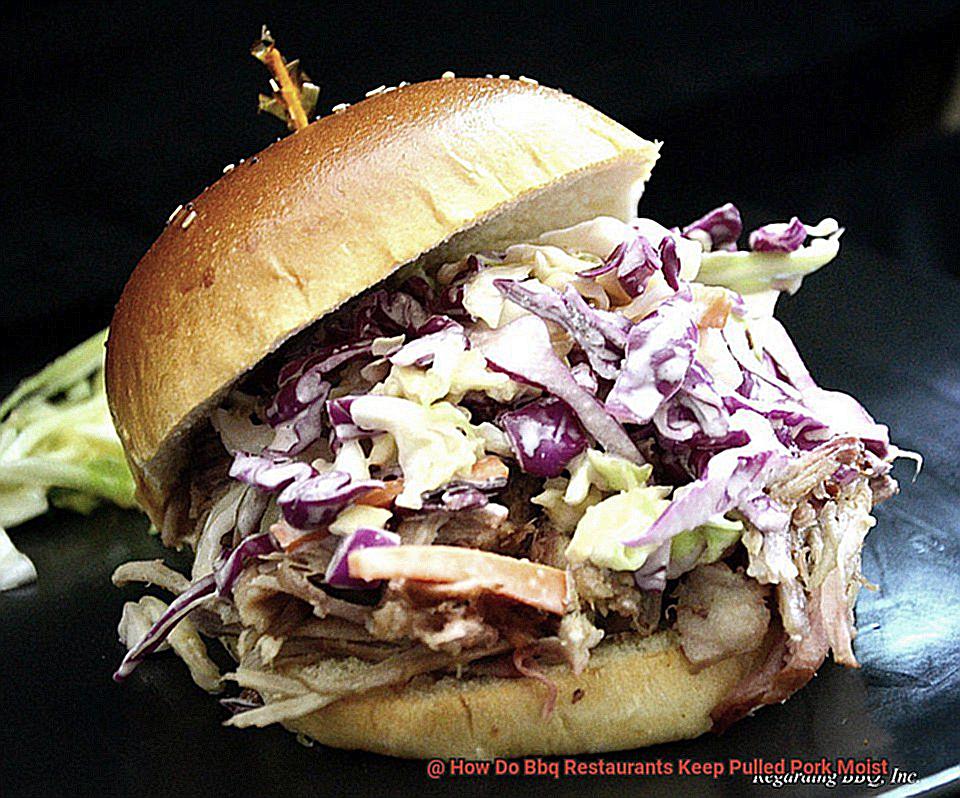
- Can create a steamed texture rather than a smoked flavor.
- May cause the bark on the outside of the pork to become soft and lose its crispiness.
To ensure that this method works effectively, it’s important to wrap the pork tightly with foil or butcher paper. This will prevent steam from escaping and will help to retain moisture. Additionally, adding liquid to the wrap plays a crucial role in keeping the meat moist and tender.
However, if you’re looking for that smoky flavor, then this method may not be for you. Wrapping in foil can create a steamed texture rather than a smoked flavor, which can be disappointing for those who love that smoky taste.
Letting the Pork Rest Before Serving
It’s called letting the pork rest before serving, and it’s an essential step that can make all the difference.
When meat is cooked, the heat causes the juices to move towards the center of the meat, leaving the outer edges dry and tough. By allowing the pork to rest, these juices are redistributed throughout the meat, resulting in a more even distribution of moisture and tenderness. This means that every bite of your pulled pork will be as juicy and tender as the last.
But that’s not all. Letting the pork rest also allows the internal temperature of the meat to even out, which can help prevent overcooked or dry areas. This ensures that your pulled pork will be cooked to perfection without any tough or chewy bits.
So how long should you let your pulled pork rest? The length of time needed for resting can vary depending on the size of the pork and cooking method used. However, a good rule of thumb is to let the pork rest for at least 30 minutes before serving. This allows enough time for the juices to redistribute without causing the meat to cool down too much.
In addition to achieving a delicious end result, BBQ restaurants use this technique to ensure consistent quality in their pulled pork dishes. By letting their pork rest before serving, they are able to deliver juicy and tender pulled pork every time, keeping their customers coming back for more.
Tips for Achieving Restaurant-Quality Pulled Pork at Home
The key to tender pulled pork is selecting the right cut of meat. Pork shoulder or Boston butt are the go-to choices for BBQ restaurants because they have plenty of fat and marbling, which keeps the meat juicy during cooking. Make sure to choose a cut with ample marbling for maximum flavor and tenderness.
Cook Low and Slow
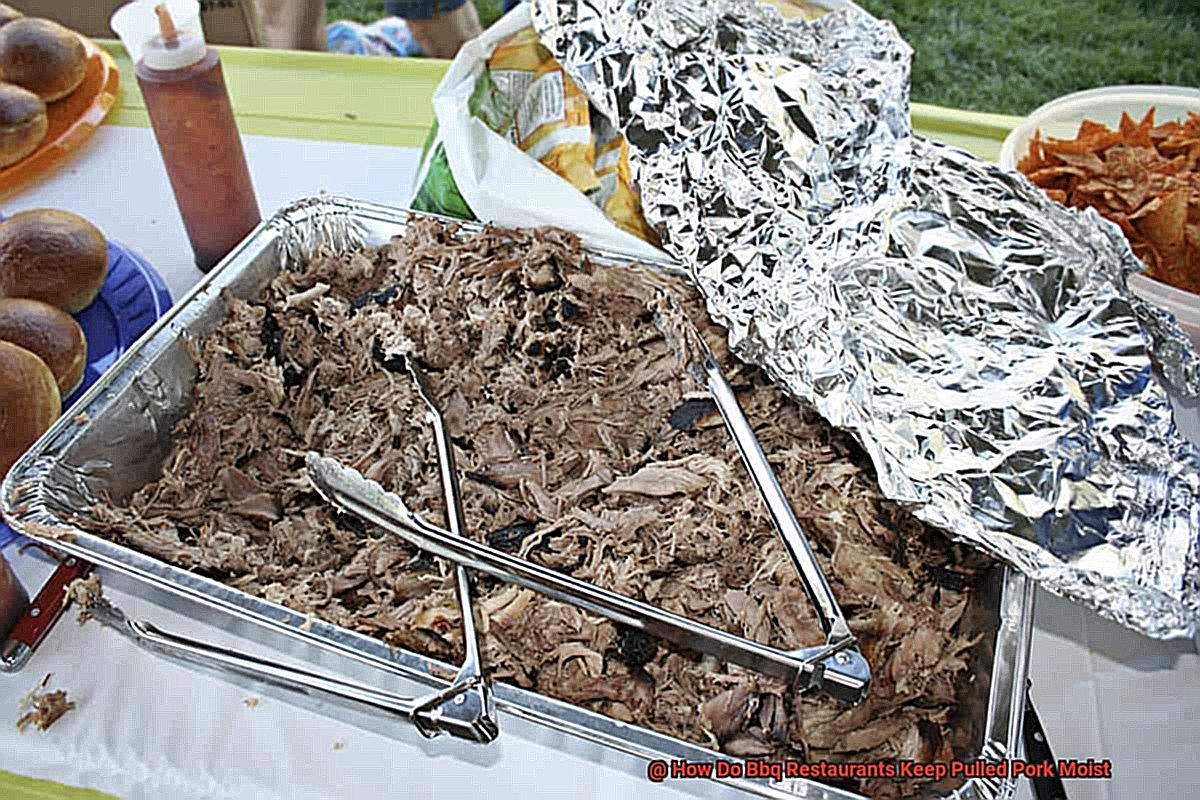
Cooking low and slow is essential for achieving tender, flavorful pulled pork. This means cooking the meat at a low temperature (around 225-250°F) for an extended period (8-12 hours). The low temperature allows the fat to melt and penetrate the meat, resulting in a moist and tender end product. Use a thermometer to ensure that the temperature remains consistent throughout the cooking process.
Use a Dry Rub or Marinade
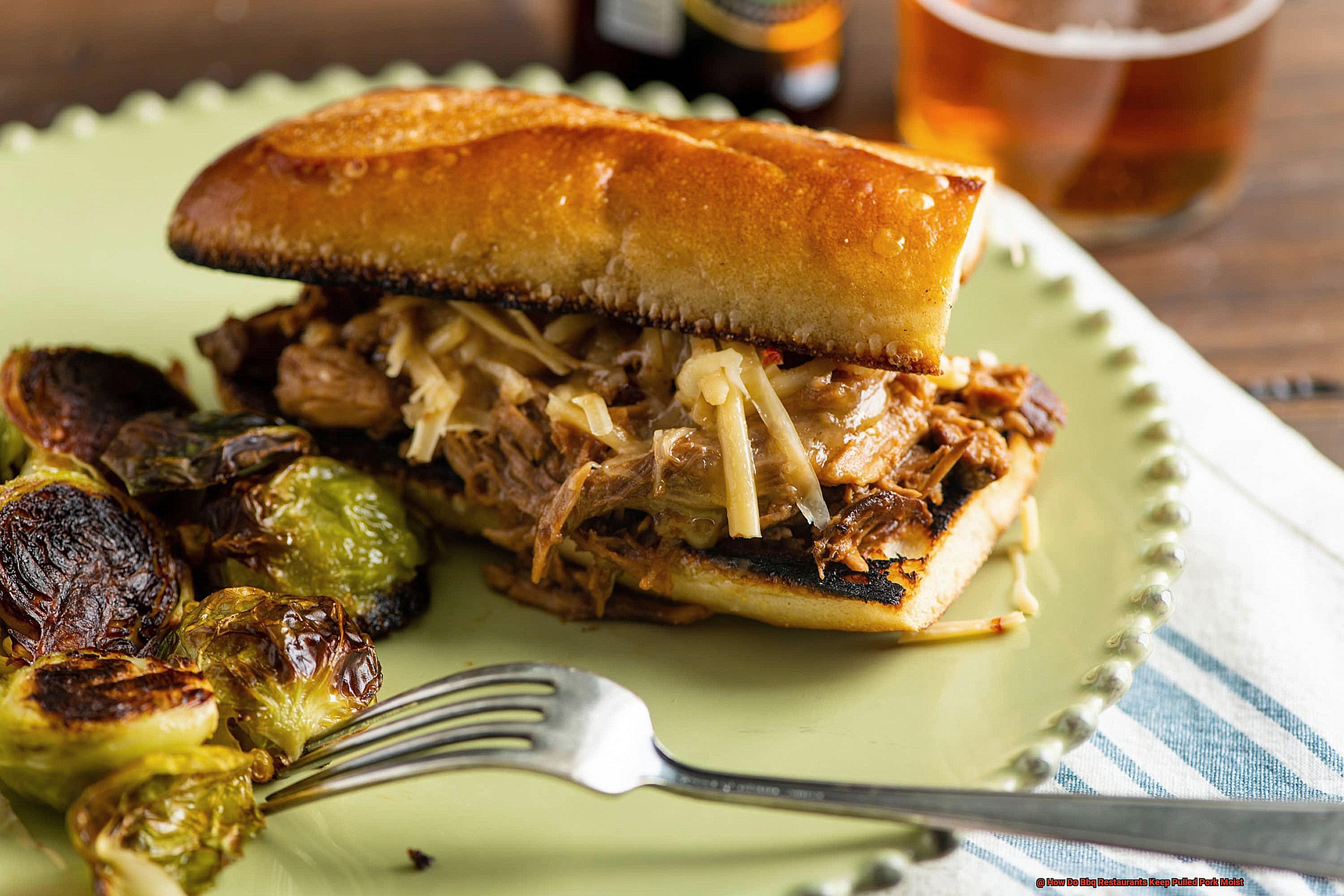
A dry rub or marinade can add extra flavor and moisture to your pulled pork. A dry rub typically consists of a blend of spices and herbs that are rubbed onto the meat before cooking. A marinade is a liquid mixture that the meat is soaked in before cooking. Both methods infuse the meat with delicious flavors while helping to keep it moist and tender.
Let the Meat Rest
Allowing your cooked meat to rest before shredding it is crucial for maintaining its juiciness and flavor. Resting for at least 30 minutes allows the juices to redistribute throughout the meat, resulting in a more flavorful and tender end product. Tent the meat loosely with foil during resting to keep it warm.
Use a High-Quality BBQ Sauce
A high-quality BBQ sauce can take your pulled pork to the next level by adding extra moisture and flavor. Look for a sauce that is thick and has a balance of sweet and tangy flavors. You can either brush the sauce on during cooking or serve it on the side for dipping. Choose your favorite sauce or experiment with different varieties to find your perfect match.
Common Mistakes to Avoid When Making Pulled Pork
Before you start, let me share some common mistakes to avoid to ensure that your pork turns out tender and juicy.
Firstly, don’t forget to season your meat before cooking. A dry rub or marinade will not only add flavor but also help the meat retain moisture during the cooking process.
Secondly, overcooking is a grave mistake that can ruin your dish. Make sure to cook your pork until it reaches an internal temperature of 195-205 degrees Fahrenheit, but don’t go beyond that point as it will make the meat dry and tough.
Thirdly, using the wrong cut of meat can lead to a dry final product. Choose a cut of pork with enough fat content such as a shoulder or butt. The fat will keep the meat moist and add flavor.
Lastly, don’t forget to rest the meat after cooking. Letting it rest for 20-30 minutes before pulling it apart allows the juices to redistribute throughout the meat, resulting in a more tender and moist final product.
03BW__z7fng” >
Conclusion
In summary, the key to achieving succulent and juicy pulled pork lies in the meticulous preparation, cooking, and storage techniques employed by seasoned pitmasters. Injecting liquid solutions, brining, wrapping in foil or butcher paper, and allowing the meat to rest before serving are all essential methods utilized by BBQ restaurants to ensure their pulled pork is bursting with flavor.
Cooking low and slow is a critical factor in creating tender and delicious pulled pork. Selecting the right cut of meat, using a dry rub or marinade, and incorporating a high-quality BBQ sauce can also contribute significantly to making an irresistible dish.
Nonetheless, there are common pitfalls that one should avoid when preparing pulled pork at home. Proper seasoning of the meat, avoiding overcooking it, selecting cuts with adequate fat content, and letting it rest after cooking are all crucial considerations.
By following these tips from experienced pitmasters, you too can create mouth-watering pulled pork packed with moisture and flavor. Whether you’re cooking for a large gathering or just yourself, these techniques will guarantee restaurant-quality results every time.

